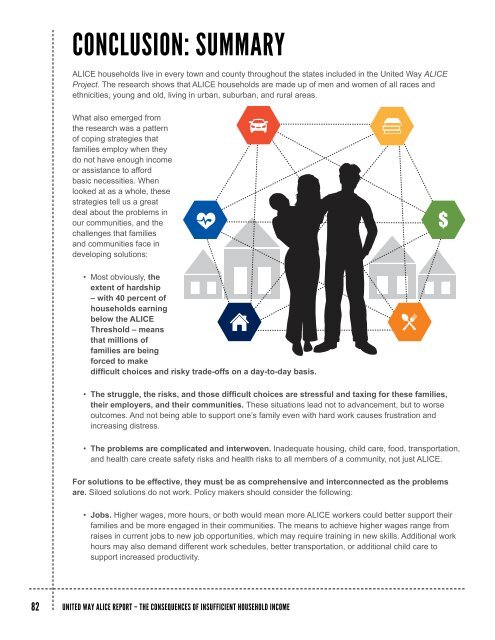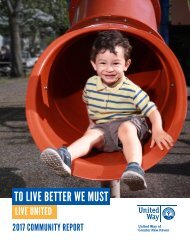The Consequences of Insufficient Household Income
This new Consequences of Insufficient Household Income report provides a deeper level of understanding of the choices that ALICE and poverty-level families across the country make when they do not have enough income or assistance to afford basic necessities, and the consequences of those choices.
This new Consequences of Insufficient Household Income report provides a deeper level of understanding of the choices that ALICE and poverty-level families across the country make when they do not have enough income or assistance to afford basic necessities, and the consequences of those choices.
You also want an ePaper? Increase the reach of your titles
YUMPU automatically turns print PDFs into web optimized ePapers that Google loves.
CONCLUSION: SUMMARY<br />
ALICE households live in every town and county throughout the states included in the United Way ALICE<br />
Project. <strong>The</strong> research shows that ALICE households are made up <strong>of</strong> men and women <strong>of</strong> all races and<br />
ethnicities, young and old, living in urban, suburban, and rural areas.<br />
What also emerged from<br />
the research was a pattern<br />
<strong>of</strong> coping strategies that<br />
families employ when they<br />
do not have enough income<br />
or assistance to afford<br />
basic necessities. When<br />
looked at as a whole, these<br />
strategies tell us a great<br />
deal about the problems in<br />
our communities, and the<br />
challenges that families<br />
and communities face in<br />
developing solutions:<br />
• Most obviously, the<br />
extent <strong>of</strong> hardship<br />
– with 40 percent <strong>of</strong><br />
households earning<br />
below the ALICE<br />
Threshold – means<br />
that millions <strong>of</strong><br />
families are being<br />
forced to make<br />
difficult choices and risky trade-<strong>of</strong>fs on a day-to-day basis.<br />
• <strong>The</strong> struggle, the risks, and those difficult choices are stressful and taxing for these families,<br />
their employers, and their communities. <strong>The</strong>se situations lead not to advancement, but to worse<br />
outcomes. And not being able to support one’s family even with hard work causes frustration and<br />
increasing distress.<br />
• <strong>The</strong> problems are complicated and interwoven. Inadequate housing, child care, food, transportation,<br />
and health care create safety risks and health risks to all members <strong>of</strong> a community, not just ALICE.<br />
For solutions to be effective, they must be as comprehensive and interconnected as the problems<br />
are. Siloed solutions do not work. Policy makers should consider the following:<br />
• Jobs. Higher wages, more hours, or both would mean more ALICE workers could better support their<br />
families and be more engaged in their communities. <strong>The</strong> means to achieve higher wages range from<br />
raises in current jobs to new job opportunities, which may require training in new skills. Additional work<br />
hours may also demand different work schedules, better transportation, or additional child care to<br />
support increased productivity.<br />
82 UNITED WAY ALICE REPORT – THE CONSEQUENCES OF INSUFFICIENT HOUSEHOLD INCOME




